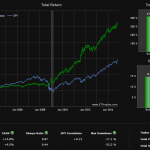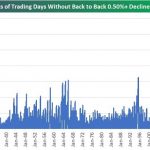Ed Thorp, the father of quant investing, might be the most impressive market wizard. He turned seemingly random processes into predictable events, transforming the art of speculation into a science decades before Wall Street’s quants became mainstream.
His domination in the financial world began in the casino. Thorp figured out how to beat the most “unbeatable” games. In roulette, he created a wearable computer that gave him a 44% edge. And in blackjack, he developed the very first card counting system that’s still widely used today.
These gambling skills transferred perfectly to markets. Thorp’s first hedge fund, Princeton Newport Partners, never had a down year. It compounded money at 19.1% for almost 20 years — destroying the S&P 500.
His second fund, which he ran from August 1992 to September 2002, performed just as well with an annualized return of 18.2%.
Thorp’s list of discoveries, inventions, and people he’s influenced and invested in is comically long:
And the list goes on…
Thorp’s advice on approaching games of incomplete information is methodical and scientific, making it very useful to incorporate into your own trading process. The following is his most valuable wisdom with our commentary attached:
Rare Events (Fat Pitches)
Fat pitches — the types of trades Buffett, Druck, and Soros salivate over— happen seldomly. And that makes sense because is takes extraordinary circumstances to push markets far enough from equilibrium to create these opportunities.
When these dislocations occur, it pays to go on high alert. It’s possible to make your year or even your career in a few days by hitting these fat pitches on the nose.
Here are a few of Thorp’s best plays:
1987 Crash
Black Monday was a traumatizing experience for most traders… but not for Thorp. When the crash started to accelerate Thorp was having his daily lunch date with his wife Vivian. The office called to report the news and Thorp didn’t even flinch. He had already accounted for all possible market scenarios, including this one, and didn’t have any reason to panic. He calmly finished his lunch and then went home to think about how to exploit the situation. This is what he came up with:
After thinking hard about it overnight I concluded that massive feedback selling by the portfolio insurers was the likely cause of Monday’s price collapse. The next morning S&P futures were trading at 185 to 190 and the corresponding price to buy the S&P itself was 220. This price difference of 30 to 35 was previously unheard of, since arbitrageurs like us generally kept the two prices within a point or two of each other. But the institutions had sold massive amounts of futures, and the index itself didn’t fall nearly as far because the terrified arbitrageurs wouldn’t exploit the spread. Normally when futures were trading far enough below the index itself, the arbitrageurs sold short a basket of stocks that closely tracked the index and bought an offsetting position in the cheaper index futures. When the price of the futures and that of the basket of underlying stocks converged, as they do later when the futures contracts settle, the arbitrageur closes out the hedge and captures the original spread as a profit. But on Tuesday, October 20, 1987, many stocks were difficult or impossible to sell short. That was because of the uptick rule.
It specified that, with certain exceptions, short-sale transactions are allowed only at a price higher than the last previous different price (an “uptick”). This rule was supposed to prevent short sellers from deliberately driving down the price of a stock. Seeing an enormous profit potential from capturing the unprecedented spread between the futures and the index, I wanted to sell stocks short and buy index futures to capture the excess spread. The index was selling at 15 percent, or 30 points, over the futures. The potential profit in an arbitrage was 15 percent in a few days. But with prices collapsing, upticks were scarce. What to do?
I figured out a solution. I called our head trader, who as a minor general partner was highly compensated from his share of our fees, and gave him this order: Buy $5 million worth of index futures at whatever the current market price happened to be (about 190), and place orders to sell short at the market, with the index then trading at about 220, not $5 million worth of assorted stocks—which was the optimal amount to best hedge the futures—but $10 million. I chose twice as much stock as I wanted, guessing only about half would actually be shorted because of the scarcity of the required upticks, thus giving me the proper hedge. If substantially more or less stock was sold short, the hedge would not be as good but the 15 percent profit cushion gave us a wide band of protection against loss.
In the end we did get roughly half our shorts off for a near-optimal hedge. We had about $9 million worth of futures long and $10 million worth of stock short, locking in $1 million profit. If my trader hadn’t wasted so much of the market day refusing to act, we could have done several more rounds and reaped additional millions.














Leave A Comment